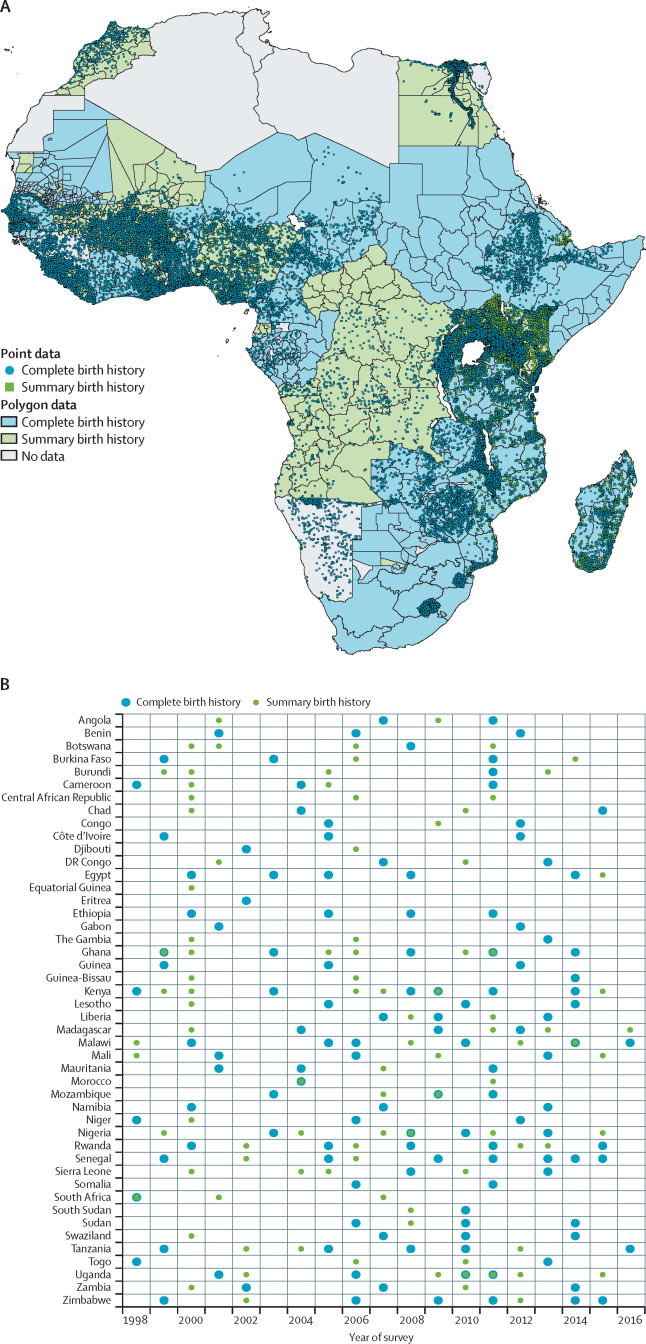The Lancet ( IF 168.9 ) Pub Date : 2017-09-25 , DOI: 10.1016/s0140-6736(17)31758-0 Nick Golding , Roy Burstein , Joshua Longbottom , Annie J Browne , Nancy Fullman , Aaron Osgood-Zimmerman , Lucas Earl , Samir Bhatt , Ewan Cameron , Daniel C Casey , Laura Dwyer-Lindgren , Tamer H Farag , Abraham D Flaxman , Maya S Fraser , Peter W Gething , Harry S Gibson , Nicholas Graetz , L Kendall Krause , Xie Rachel Kulikoff , Stephen S Lim , Bonnie Mappin , Chloe Morozoff , Robert C Reiner , Amber Sligar , David L Smith , Haidong Wang , Daniel J Weiss , Christopher J L Murray , Catherine L Moyes , Simon I Hay

|
Background
During the Millennium Development Goal (MDG) era, many countries in Africa achieved marked reductions in under-5 and neonatal mortality. Yet the pace of progress toward these goals substantially varied at the national level, demonstrating an essential need for tracking even more local trends in child mortality. With the adoption of the Sustainable Development Goals (SDGs) in 2015, which established ambitious targets for improving child survival by 2030, optimal intervention planning and targeting will require understanding of trends and rates of progress at a higher spatial resolution. In this study, we aimed to generate high-resolution estimates of under-5 and neonatal all-cause mortality across 46 countries in Africa.
Methods
We assembled 235 geographically resolved household survey and census data sources on child deaths to produce estimates of under-5 and neonatal mortality at a resolution of 5 × 5 km grid cells across 46 African countries for 2000, 2005, 2010, and 2015. We used a Bayesian geostatistical analytical framework to generate these estimates, and implemented predictive validity tests. In addition to reporting 5 × 5 km estimates, we also aggregated results obtained from these estimates into three different levels—national, and subnational administrative levels 1 and 2—to provide the full range of geospatial resolution that local, national, and global decision makers might require.
Findings
Amid improving child survival in Africa, there was substantial heterogeneity in absolute levels of under-5 and neonatal mortality in 2015, as well as the annualised rates of decline achieved from 2000 to 2015. Subnational areas in countries such as Botswana, Rwanda, and Ethiopia recorded some of the largest decreases in child mortality rates since 2000, positioning them well to achieve SDG targets by 2030 or earlier. Yet these places were the exception for Africa, since many areas, particularly in central and western Africa, must reduce under-5 mortality rates by at least 8·8% per year, between 2015 and 2030, to achieve the SDG 3.2 target for under-5 mortality by 2030.
Interpretation
In the absence of unprecedented political commitment, financial support, and medical advances, the viability of SDG 3.2 achievement in Africa is precarious at best. By producing under-5 and neonatal mortality rates at multiple levels of geospatial resolution over time, this study provides key information for decision makers to target interventions at populations in the greatest need. In an era when precision public health increasingly has the potential to transform the design, implementation, and impact of health programmes, our 5 × 5 km estimates of child mortality in Africa provide a baseline against which local, national, and global stakeholders can map the pathways for ending preventable child deaths by 2030.
Funding
Bill & Melinda Gates Foundation.
中文翻译:

绘制2000-15年非洲5岁以下儿童和新生儿死亡率的图:可持续发展目标的基线分析
背景
在千年发展目标时代,非洲许多国家的5岁以下儿童和新生儿死亡率显着降低。然而,在国家一级实现这些目标的步伐差别很大,这表明迫切需要追踪儿童死亡率的更多本地趋势。随着2015年可持续发展目标(SDG)的通过,该目标确立了到2030年改善儿童生存的雄心勃勃的目标,最佳的干预计划和目标将需要在更高的空间分辨率下了解趋势和进展速度。在这项研究中,我们旨在对非洲46个国家/地区的5岁以下儿童和新生儿全因死亡率进行高分辨率估计。
方法
我们收集了235个按地理区域划分的家庭调查和儿童死亡普查数据源,以2000年,2005年,2010年和2015年在5个非洲国家/地区的5×5 km网格分辨率下估算了5岁以下儿童和新生儿的死亡率。贝叶斯地统计分析框架以生成这些估计值,并实施了预测有效性测试。除了报告5×5 km的估算值之外,我们还将从这些估算值中获得的结果汇总到三个不同的级别(国家和地方行政级别1和2)中,以提供本地,国家和全球决策者的全方位地理空间分辨率可能需要。
发现
随着非洲儿童生存状况的改善,2015年5岁以下儿童的绝对水平和新生儿死亡率存在很大的异质性,而且2000年至2015年的年均下降率也存在差异。博茨瓦纳,卢旺达和埃塞俄比亚等国家的地方以下地区记录显示,自2000年以来,儿童死亡率下降幅度最大,这使其能够在2030年或更早之前实现SDG目标。然而,这些地方是非洲的例外,因为许多地区,尤其是中部非洲和西非,必须在2015年至2030年之间将5岁以下儿童的死亡率每年至少降低8·8%,才能实现SDG 3.2的目标到2030年-5死亡率。
解释
在没有空前的政治承诺,财政支持和医疗进步的情况下,实现SDG 3.2在非洲的可行性充其量是不稳定的。通过随着时间的推移在多个级别的地理空间分辨率下得出5岁以下儿童和新生儿死亡率,这项研究为决策者提供了针对最需要干预的人群的关键信息。在这个时代,精确的公共卫生越来越有可能改变卫生计划的设计,实施和影响,我们对非洲儿童死亡率的5×5 km估算提供了一个基线,地方,国家和全球利益相关者可以以此为基准到2030年消除可预防的儿童死亡的途径。
资金
比尔和梅琳达·盖茨基金会。


























 京公网安备 11010802027423号
京公网安备 11010802027423号